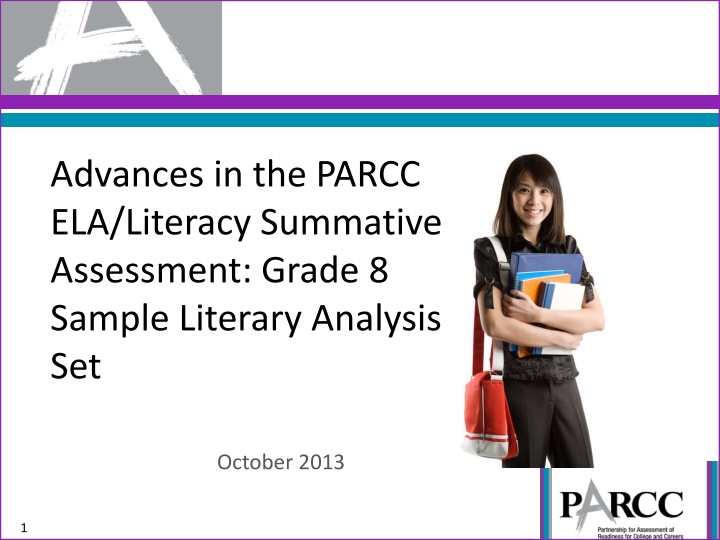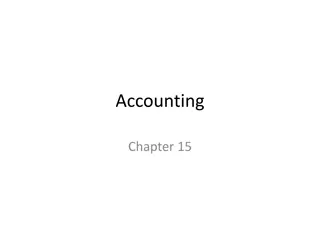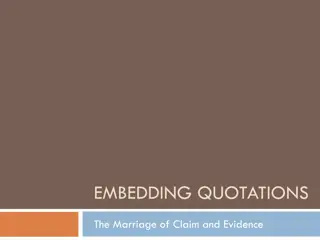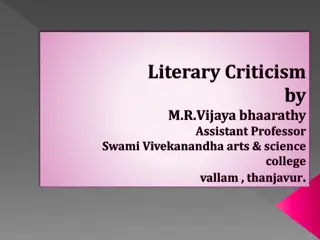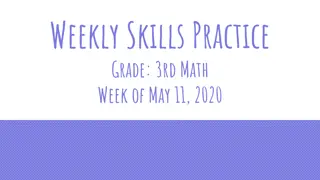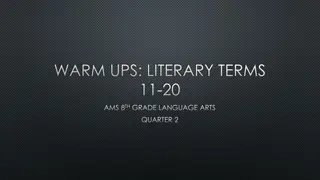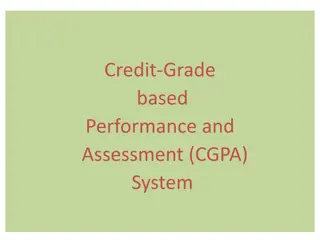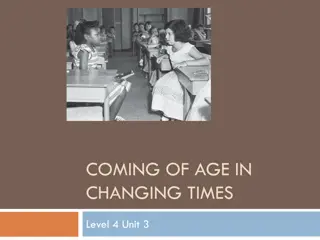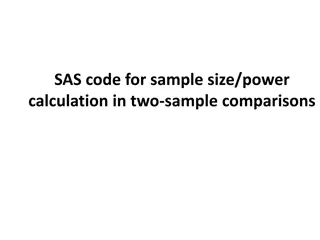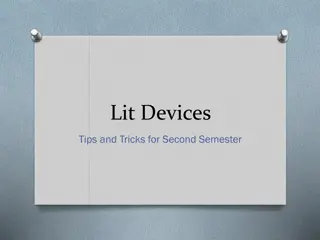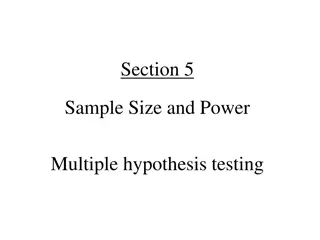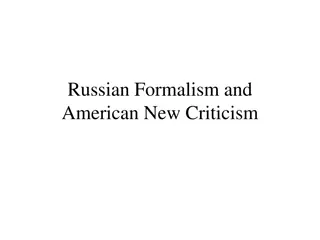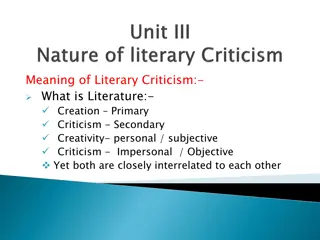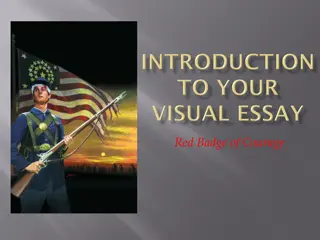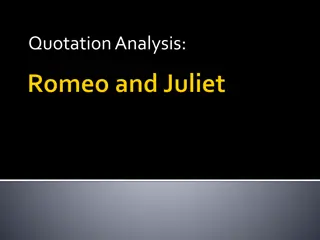Grade 8 Literary Analysis Sample Items Overview
This collection provides a detailed look at the Grade 8 Literary Analysis Task, guiding students to carefully analyze two literary texts and write a comprehensive analysis. The included sample items and tasks aim to enhance students' abilities in close reading, critical thinking, and synthesizing ideas. With a focus on texts like "Brian's Winter," students engage in answering questions, identifying word meanings, and creating summaries to demonstrate their analytical skills.
Download Presentation

Please find below an Image/Link to download the presentation.
The content on the website is provided AS IS for your information and personal use only. It may not be sold, licensed, or shared on other websites without obtaining consent from the author.If you encounter any issues during the download, it is possible that the publisher has removed the file from their server.
You are allowed to download the files provided on this website for personal or commercial use, subject to the condition that they are used lawfully. All files are the property of their respective owners.
The content on the website is provided AS IS for your information and personal use only. It may not be sold, licensed, or shared on other websites without obtaining consent from the author.
E N D
Presentation Transcript
Advances in the PARCC ELA/Literacy Summative Assessment: Grade 8 Sample Literary Analysis Set October 2013 1
Grade 8 Sample Items Overview The following slides will provide the reader an overview of the new sample items for grade 8. Together, they form a complete literary analysis task(LAT). This set aligns to task generation model 8A3PBA. You can access the grades 6-8 task models at http://www.parcconline.org/sites/parcc/files/CombinedPBATa skGenerationModelsGrades6-8.pdf. 2
Understanding the Literary Analysis Task Students carefully consider two literary texts worthy of close study. They are asked to answer a few EBSR and TECR questions about each text to demonstrate their ability to do close analytic reading and to compare and synthesize ideas. Students write a literary analysis about the two texts. 3
Texts Worth Reading? Grade 8 Brian s Winter Author Gary Paulsen won the ALA Margaret Edwards Award, which recognizes an author and a particular body of work for significant and lasting contribution to young adult literature in 1997. Call of the Wild Considered an American classic and a strong example of realism 4
Sample Item #1Part A What is the meaning of the word adversary as it is used in paragraph 21? a) problem s solution b) indication of trouble c) opposing force* d) source of irritation 5
Sample Item #1Part B Which phrase from paragraph 21 best helps clarify the meaning of adversary? a) own worst enemy * b) the primary rule c) missed the warnings d) most dangerous thing 6
Sample Item #2 Create a summary of the excerpt from Brian s Winter by dragging four statements from the list and dropping them in chronological order into the table titled Summary. Note that not all statements will be used. 2 Brian attempts to scare away the bear that wakes him up.* Brian is sore as he gets into his bag that night. 1 Summary 1 The bear is more powerful than Brian thinks. 3 Brian believes that he has learned to co-exist with the bears.* 2 4 Brian takes a serious risk. 5 3 Brian thinks about solutions to his major problem.* 6 4 The bear tosses Brian and eats the scraps of Brian s meal.* 7 Correct Response: 4, 2, 7, 6 The bear looks at Brian and walks away. 8 The bear sits back and sniffs the air. 9 7
Sample Item #3Part A In the excerpt from Brian s Winter, Brian comes to a major realization at the end of the passage. Which statement best describes his realization? a) He needs to avoid confronting wild animals. b) He needs to prepare for the perils of winter.* c) He needs to create a better way to store food. d) He needs to find a new, safer shelter. 8
Sample Item #3Part B Which detail best supports the answer in Part A? a) The bear turned back to ransacking the camp, looking for where that delicious smell had come from. (paragraph 15) b) He would have to find some way to protect himself, some weapon. (paragraph 19) c) He kept putting wood on the fire, half afraid the bear would come back. (paragraph 20) d) he had missed the warnings that summer was ending and what was coming would be the most dangerous thing he had faced (paragraph 21)* 9
Sample Item #4Part A What does the word placatingly mean as it is used in paragraph 2? a) in a warning tone b) in an annoying manner c) in an attempt to be agreeable* d) in a way that expresses discomfort 10
Sample Item #4Part B Which phrase from the passage provides the best clue to the meaning of placatingly as it is used in paragraph 2? a) bristling and snarling b) a whiff of warm air c) squirmed and wriggled d) a bribe for peace * 11
Sample Item #5Part A Which statement best reflects a theme of the excerpt from Call of the Wild? a) Survival is unlikely when one is new to an environment. b) Survival requires adapting to one s surroundings.* c) One cannot rely on others when learning to survive. d) Advanced preparation is necessary for survival. 12
Sample Item #5Part B Which two details from the article best support the answer in Part A? a) Here and there savage dogs rushed upon him, but he bristled his neck-hair and snarled (for he was learning fast), and they let him go his way unmolested. (paragraph 1)* Again he wandered through the great camp, looking for them, and again he returned. (paragraph 2) He sprang back, bristling and snarling, fearful of the unseen and unknown. (paragraph 2) Buck confidently selected a spot, and with much fuss and wasted effort proceeded to dig a hole for himself. (paragraph 3)* It was a token that he was harking back through his own life to the lives of his forebears (paragraph 4) he saw the white camp spread out before him and knew where he was (paragraph 4) b) c) d) e) f) 13
Sample Item #6Part A Which statement correctly shows a difference between the beginnings and endings of the excerpts from Brian s Winter and Call of the Wild? a) Call of the Wild begins with a former conflict between characters, and Brian s Winter ends with a current conflict between characters. b) Brian s Winter begins by revealing a character s faulty reasoning, and Call of the Wild ends with a character s faulty reasoning. c) Call of the Wild begins with a crisis to be resolved, and Brian s Winter ends with a crisis that needs to be resolved.* d) Brian s Winter begins with the thoughts and actions of a character seeking shelter, and Call of the Wild ends with the thoughts and actions of a character seeking shelter. 14
Sample Item #6Part B Select onedetail from the list below from Brian s Winter and one detail from the list below from Call of the Wild that best support the answer in Part A. a) He had seen them several times while picking berries, raking the bushes with their teeth to pull the fruit off (Brian s Winter paragraph 2) Other than some minor scratches where the bear s claws had slightly scraped him it was more a boxing action than a clawing one Brian was in one piece. (Brian s Winter paragraph 16) Everything in nature means something and he had missed the warnings that summer was ending, had in many ways already ended, and what was coming would be the most dangerous thing he had faced since the plane crash. (Brian s Winter paragraph 21)* The tent, illumined by a candle, glowed warmly in the midst of the white plain (Call of the Wild paragraph 1) Miserable and disconsolate, he wandered about among the many tents, only to find that one place was as cold as another. (Call of the Wild paragraph 1)* The day had been long and arduous, and he slept soundly and comfortably, though he growled and barked and wrestled with bad dreams. (Call of the Wild paragraph 3) b) c) d) e) f) 15
Sample Item #7 You have read excerpts from two novels focused on survival in the wilderness. These excerpts are from: Brian s Winter by Gary Paulsen Call of the Wild by Jack London Consider how the main character in each excerpt reacts to the incidences that occur, and write an essay in which you analyze how each character s thoughts and actions reveal aspects of his personality. You do not need to compare and contrast the characters from the two texts. You may consider each one separately. Be sure to include evidence from each excerpt to support your analysis and understanding. 16
A Strong Foundation: The Common Core State Standards The Common Core State Standards in English language arts/literacy and mathematics were created by educators around the nation. Nearly every state in the nation is working individually and collectively to improve its instruction and assessments to ensure students graduate with the knowledge and skills most demanded by college and careers. The PARCC assessment rewards this commitment by providing an assessment focused on the instructional shifts and academic skills needed to prepare all students for college and career readiness in the 21st century. 17
